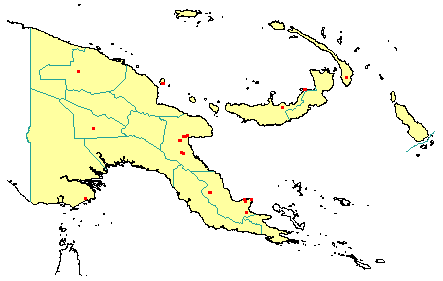
in PNGplants database
PNGTreesKey – Paraserianthes falcataria (L.) I.C.Nielsen subsp. falcataria |
Barry Conn (NSW) & Kipiro Damas (LAE).
Guide to trees of Papua New Guinea
Copyright held by the authors, National Herbarium of New South Wales, and Papua New Guinea National Herbarium
Bulletin du Muséum National d'Histoire Naturelle. Section B, Adansonia: Botanique Phytochimie Vol. 1983 (3): 327 (1983)
Other Literature: I.C. Nielsen, Flora Malesiana, Series 1 151-153 (1992) Fig. 24.
Family: Fabaceae
Dicotyledon
Timber Group: (moulding, formwork, canoes and shields) Minor hardwood Tradename: Albizzia
Field Characters: Large canopy tree (12-40 m high) or Small sub-canopy tree; Bole cylindrical (to slightly fluted near base); straight; buttresses buttresses present (buttresses up to 0.5 m long) or buttresses absent; spines spines absent; aerial roots aerial roots absent; stilt roots stilt roots absent; Bark white, pale green, greenish grey, or pale brown, rough (slightly (slightly warty) or smooth, sometimes fissured or slightly pustular, lenticels elongated vertically (brown); Subrhytidome (under-bark) green, dark red, or brown; less than 25 mm thick, 10.0 (c.); bark blaze consisting of one layer or with two layers (often not distinct); strongly aromatic; pleasant; outer blaze white, pale yellow, pink, or red, with stripes, fibrous; inner blaze white (or straw-coloured), pale yellow, pink, or red (pale not readily distinct from outer blaze), with stripes (faint), fibrous; bark exudate (sap) present, red (pale (pink), not readily flowing (spotty), colour not changing on exposure to air, sticky; terminal buds not enclosed by leaves.
Indumentum: Complex hairs absent; stinging hairs absent; mature twig indumentum (hairs) present, hairs dense.
Leaves: Leaves spaced along branches, spiral (leaves occurring singly at a node and arranged spirally up the branchlet), compound (a leaf made up from two or more leaflets); petiole present, not winged, attached to base of leaf blade, swollen (usually with an oval gland near base); leaves bipinnate (with the rachis branched once); petiolule not swollen; rachis present, absent, absent; leaves without a terminal leaflet (the number of leaflets even - paripinnate), broadest at or near middle or equally broad throughout much of length, 1.5 (-2.0) cm, 0.5 (c.) cm, leaflets opposite, symmetric; venation pinnate (with 3 veins arising from base, pinnate above; midrib to one side), secondary veins open, prominent or not prominent, but visible, intramarginal veins absent; leaves lower surface pale green or greenish grey, upper surface blue-green or pale green, indumentum (hairs) absent or present (covered with very fine short hairs), indumentum (hairs) dense or sparse; absent; domatia absent; stipules absent.
Flowers: Inflorescence axillary, flowers on a branched axis, cones absent; flowers bisexual, stalked, flowers with many planes of symmetry, 3.0-4.5 mm long, diameter small (up to10 mm diam.); perianth present, with distinct sepals and petals whorls, inner perianth white or greenish yellow; 4-5 (-6), some or partly joined; stamens 19-50, present, joined (to form a staminal tube), free of the perianth; ovary superior, carpels joined (when more than one), locules 1; styles solitary, 1.
Fruits: Infrutescence arranged on branched axis, fruit 90.0-120.0 mm long, brown, not spiny, non-fleshy, simple, dehiscent, legume; seeds 12-15, about 10 mm long (c. 7 mm long), not winged, broad (as wide as long), seed 1-10 mm diam. (flattened, c. 3.5 X c. 1.5 mm).
Distribution: West Sepik, East Sepik, Madang, Morobe, Western Highlands, Eastern Highlands, Southern Highlands, Western, Gulf, Central, Northern, Milne Bay, New Britain, New Ireland, Manus & Bougainville.
 | Botanical records in PNGplants database |
Notes: Notes This subspecies is classified in Fabaceae subfamily Mimosoideae or in the separate family Mimosaceae.